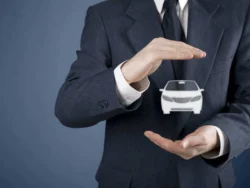
Press Release (ePRNews.com) - AUSTIN, Texas - Nov 01, 2016 (UTC) - The Zebra, the nation’s most most visited car insurance comparison marketplace, today distributed the results of a study exploring the impact of new technology on auto insurance rates, revealing that drivers with new and advanced anti-theft and safety technology features in their cars see little to no reward or discounts from auto insurance companies – despite the proven benefits of the technology.
(See full study with state-by-state results.)
Avoiding crashes and maintaining a clean driving record is absolutely one of the best ways to save on car insurance, but drivers are human. So while we’re fortunate that technology exists to help us avoid crashes and stay safer on the roads, shouldn’t drivers who seek that help and drive cars with that life-saving technology be rewarded by their auto insurance companies?
“Consumers are constantly seeking methods to lower their auto insurance rates. Avoiding crashes and maintaining a clean driving record is absolutely one of the best ways to do that,” The Zebra COO Joshua Dziabiak said. “But drivers are human. So while we’re fortunate that technology exists to help us avoid crashes and stay safer on the roads, shouldn’t drivers who seek that help and drive cars with that life-saving technology be rewarded by their auto insurance companies?”
Drivers Using Vehicle Safety and Security Tech Save Less Than 1% on Insurance
Of nine safety features studied (blind spot warning, driver alertness monitoring, collision preparation systems, lane departure warning, night vision, parking assistance, rear-view cameras, heads-up displays, and electronic stability control), only one – electronic stability control (ESC) – shows any reduction on average national premiums, though it saves just $5 per year. In fact, 17 states show no auto insurance savings at all for any of these safety devices.
Auto insurance savings are also largely insignificant for the four anti-theft devices studied:
-
Passive disabling devices: $11 per year (just 0.83% of national average annual $1,323 premium*)
-
Tracking devices: $9
-
Active disabling devices: $7
-
Audible alarm: $6
Yet Tech Features Proven to Improve Safety and Security
In 2015, traffic fatalities in the U.S. reached 35,092. A decade prior, however, they were 25 percent higher. The Department of Transportation (DOT) has cited safety programs and vehicle improvements such as airbags and ESC as having contributed to reducing traffic fatalities so substantially.
In studies by the National Highway Traffic Safety Administration (NHTSA), the Insurance Institute for Highway Safety (IIHS), and the American Automobile Association (AAA), among others, nearly all of the 13 collective vehicle safety and anti-theft devices in The Zebra’s study have been verified as effective technologies, and the others are undergoing further research.
Seven of the nine safety devices effectively provide some proven level of safety utility. In fact, the NHTSA officially recommends the use of rear-view cameras, lane departure warning, and collision preparation systems, as well as ESC, which has been a standard requirement for all new vehicles since September 2011. However, eight of the nine features yield no savings at all on auto insurance policies.
…and Consumers Seek New Safety Tech When Car Shopping
In J.D. Power’s 2015 U.S. Tech Choice Study, 5,300 consumers weighed in on the technology they’d seek in their next vehicles, and three of the top five features were related to collision prevention. Forty percent of respondents would look for blind spot monitoring, 33 percent for night vision systems, 30 percent for collision mitigation technology, and another 30 percent for rear-view cameras.
Why Aren’t Insurers Discounting Safer and More Secure Cars?
-
Insurance companies say some of the technology features lack sufficient long-term studies to verify that they would truly lower the risk of a crash.
-
Even with advanced technology, there is still a lot of room for driver error. Some drivers even deactivate “annoying” features, like lane departure warning.
-
An anti-theft feature discount would apply only to the comprehensive portion of a premium, and a safety feature discount only to personal injury protection (PIP) or medical coverage, rather than the full premium (and that is if the driver opts for that coverage).
-
Insurance companies are taking major losses. Weather, crime, an influx of uninsured drivers, or a number of other factors can cause the number of claims to skyrocket for an insurance company, and (as a business), they might not be able to offer additional discounts to drivers in order to remain financially solvent.
“The silver lining here is that automakers are developing increasingly effective safety and anti-theft technology – and consumers want it,” Dziabiak said. “Insurance carriers are often looking for ways to provide discounts to promote safe driving, so we see a great opportunity for them to partner with automakers to share data regarding the impact of these technologies on incidents and claims. Together, they can potentially simplify and speed up the process to improve safety and security and to reward drivers with insurance discounts.”
See full study with full state-by-state results: “Don’t Count on Safe Car Technology to Lower Your Insurance Rate”
*Methodology: The Zebra explored auto insurance pricing data as impacted by four anti-theft and nine safety technology devices using its quote engine, comprising data from insurance rating platforms and public rate filings. Analysis includes the majority of top national carriers across all United States zip codes for a 30-year-old single male driving a 2012 Honda Accord EX. For more details, see The Zebra’s 2016 State of Auto Insurance Pricing Report.
About The Zebra
The Zebra is the most comprehensive online car insurance comparison platform in the U.S. Since 2012, the company has sought to bring transparency and simplicity to car insurance shopping — “car insurance in black and white.” With The Zebra’s real-time, side-by-side quote comparison tool, drivers can identify insurance companies with the coverage, service level, and pricing to suit their unique needs. Headquartered in Austin, Texas, The Zebra compares over 200 car insurance companies and provides agent support and educational resources to meet ensure drivers are equipped to make the most informed decisions about their car insurance.
Media contact:
Alyssa Connolly
The Zebra
Phone: 773.59.ZEBRA
press@thezebra.com
The Zebra
98 San Jacinto Blvd. Suite 2000
Austin, TX 78701
Website: https://www.thezebra.com/




